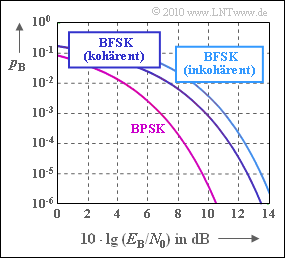Exercise 4.18Z: BER of Coherent and Non-Coherent FSK
The diagram shows the bit error probability for a binary "FSK modulation" (BFSK) with
- coherent demodulation or
- incoherent demodulation
in comparison with binary phase modulation (BPSK). Orthogonality is always assumed. For coherent demodulation, the modulation index $h$ can be a multiple of $0.5$, so that the average curve is also valid for Minimum Shift Keying (MSK). On the other hand, for non-coherent demodulation of an FSK, the modulation index $h$ must be a multiple of $1$.
This system comparison is based on the AWGN channel, characterized by the ratio $E_{\rm B}/N_0$. The equations for the bit error probabilities are as follows for
- Binary Frequency Shift Keying (BFSK) with coherent demodulation:
- $$p_{\rm B} = {\rm Q } \left ( \sqrt {{E_{\rm B}}/{N_0} }\right ) \hspace{0.05cm}.$$
- Binary Frequency Shift Keying (BFSK) with incoherent demodulation:
- $$p_{\rm B} = {1}/{2} \cdot {\rm e}^{- E_{\rm B}/{(2N_0) }}\hspace{0.05cm}.$$
- Binary Phase Shift Keying (BPSK), only coherent demodulation possible:
- $$p_{\rm B} = {\rm Q } \left ( \sqrt {{2 \cdot E_{\rm B}}/{N_0} }\right ) \hspace{0.05cm}.$$
For BPSK, the log ratio $10 \cdot {\rm lg} \, (E_{\rm B}/N_0)$ must be at least $9.6 \, \rm dB$ so that the bit error probability does not exceed the value $p_{\rm B} = 10^{\rm -5}$.
For binary modulation methods, $p_{\rm B}$ can also be replaced by $p_{\rm S}$ and $E_{\rm B}$ by $E_{\rm S}$. Then we speak of the symbol error probability $p_{\rm S}$ and the symbol energy $E_{\rm S}$.
Notes:
- The exercise belongs to the chapter "Carrier Frequency Systems with Non-Coherent Demodulation".
- However, reference is also made to the chapter "Carrier Frequency Systems with Coherent Demodulation".
- Further information can be found in the book "Modulation Methods".
- Use the approximation ${\rm lg}(2) \approx 0.3$.
Questions
Musterlösung
- In anderen Worten: Die kohärente BFSK–Kurve liegt um $10 \cdot {\rm lg} \, (2) \approx 3 \ \rm dB$ rechts von der BPSK–Kurve. Um $p_{\rm B} ≤ 10^{\rm –5}$ zu garantieren, muss gelten:
- $$10 \cdot {\rm lg}\hspace{0.05cm} {E_{\rm B}}/ {N_{\rm 0}}\approx 9.6\,\,{\rm dB} + 3\,\,{\rm dB}\hspace{0.15cm} \underline{=12.6\,\,{\rm dB}}\hspace{0.05cm}.$$
(2) Richtig ist der Lösungsvorschlag 2:
- Die angegebene Gleichung gilt nicht nur für die MSK (diese ist eine FSK mit $h = 0.5$), sondern für jede Form von orthogonaler FSK.
- Eine solche liegt vor, wenn der Modulationsindex $h$ ein ganzzahliges Vielfaches von $0.5$ ist, zum Beispiel für $h = 1$.
- Mit $h = 0.7$ ergibt sich keine orthogonale FSK.
- Es kann gezeigt werden, dass sich für $h = 0.7$ sogar eine kleinere Fehlerwahrscheinlichkeit als bei orthogonaler FSK ergibt.
- Mit $10 \cdot {\rm lg} \, E_{\rm B}/N_0 = 12.6 \ \rm dB$ erreicht man hier sogar $p_{\rm B} \approx 10^{\rm –6}$, also eine Verbesserung um eine Zehnerpotenz.
(3) Aus der Umkehrfunktion der angegebenen Gleichung erhält man:
- $$\frac{E_{\rm B}} {2 \cdot N_{\rm 0}}= {\rm ln}\hspace{0.05cm}\frac{1}{2 p_{\rm B}}= {\rm ln}(50000)\approx 10.82\hspace{0.3cm} \Rightarrow \hspace{0.3cm} {E_{\rm B}}/ {N_{\rm 0}}= 21.64 \hspace{0.3cm}\Rightarrow \hspace{0.3cm} 10 \cdot {\rm lg}\hspace{0.09cm} {E_{\rm B}}/ {N_{\rm 0}}\hspace{0.15cm} \underline{\approx 13.4\,\,{\rm dB}}\hspace{0.05cm}.$$
(4) Aus $10 \cdot {\rm lg} \, E_{\rm B}/N_0 = 12.6 \ \rm dB$ folgt:
- $${E_{\rm B}} /{N_{\rm 0}}= 10^{1.26} \approx 16.8 \hspace{0.3cm}\Rightarrow \hspace{0.3cm} \frac{E_{\rm B}} {2 \cdot N_{\rm 0}}\approx 8.4 \hspace{0.3cm} \Rightarrow \hspace{0.3cm} p_{\rm B} = {1}/{2} \cdot {\rm e}^{- 8.4}\hspace{0.15cm} \underline{ \approx 0.012 \%}\hspace{0.05cm}.$$
Das heißt: Bei gleichem $E_{\rm B}/N_0$ wird die Fehlerwahrscheinlichkeit bei der nichtkohärenten Demodulation gegenüber der kohärenten Demodulation gemäß Teilaufgabe (1) um etwa den Faktor 11 vergrößert.
